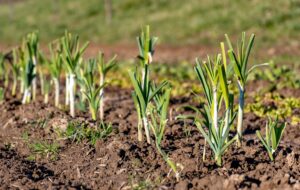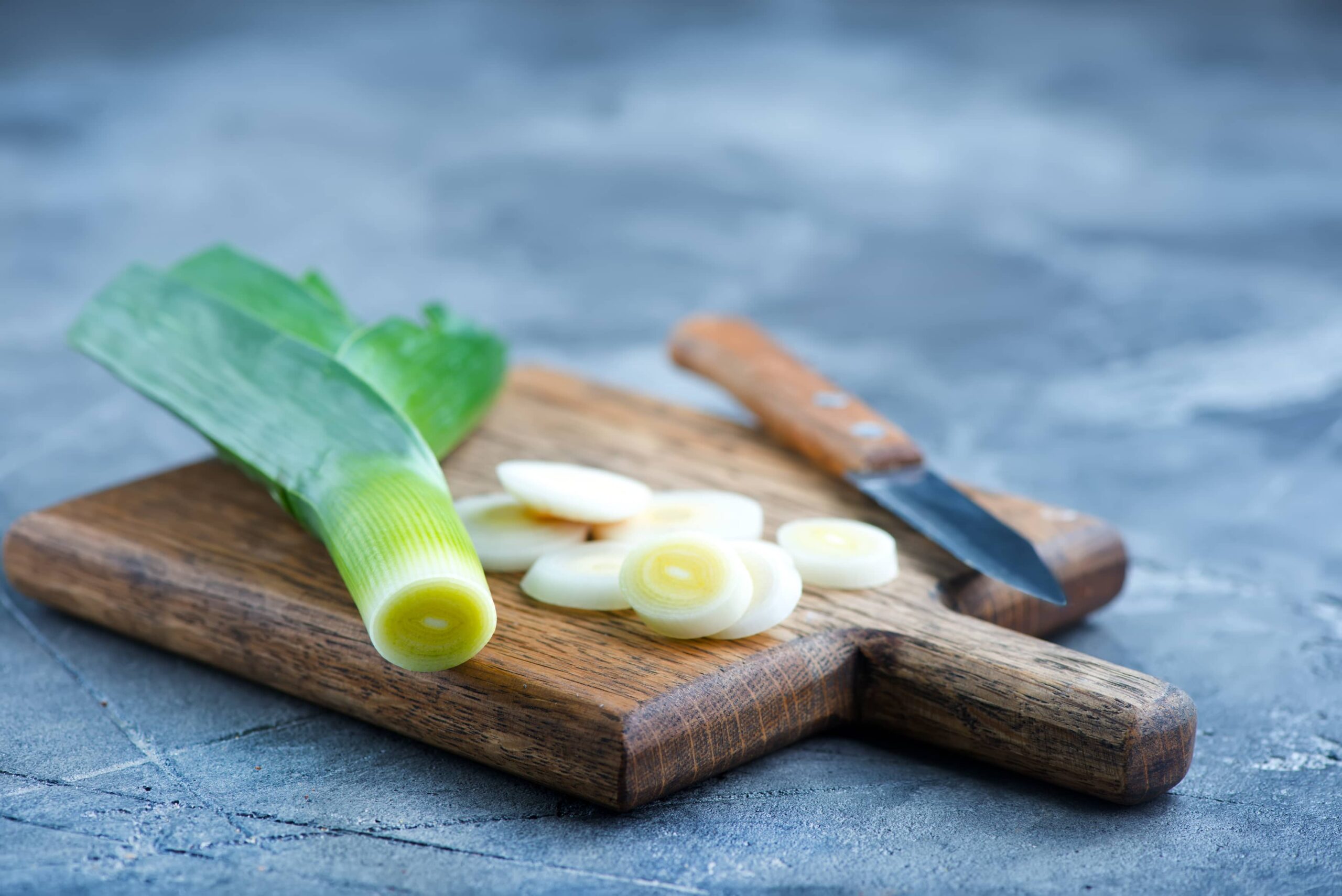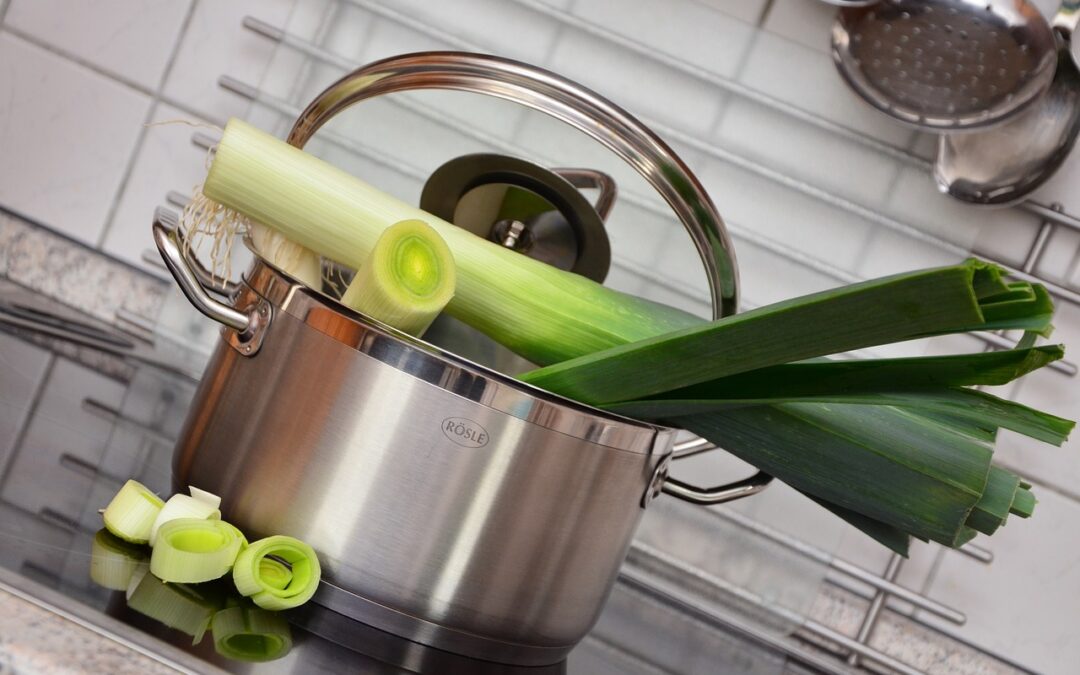Finding different foods than the ones we normally eat can help diversify our nutritional portfolio. They offer distinct flavors, and maybe offer new ways to eat familiar things by adding a previously unknown ingredient.
By changing up your menu with new food items like leeks, you can keep your diet routine exciting and make it easier to stick to. Staying consistent with healthier choices can ultimately lead to successful wellness & weight loss goals.
Leeks are those vegetables that looks like a blown up scallion [green onions]. We’ll go over what they look like, their nutritional benefits, how they might impact your weight loss and wellness goals, and some ways you can add them into your diet.
What are leeks?
 Leeks are a part of the genus Allium, which also contains plants such as garlic, onion, chives, and shallots. Unlike the onion and garlic, though, instead of growing a large bulb underground, they grow as a long and thick stalk.
Leeks are a part of the genus Allium, which also contains plants such as garlic, onion, chives, and shallots. Unlike the onion and garlic, though, instead of growing a large bulb underground, they grow as a long and thick stalk.
Leaks are in season from Fall to Winter, being harvested in October and November in the U.S.
Once grown, they can survive through most winters to be harvested, although most people harvest them as they grow.
They can make a great addition to any garden as they’re low maintenance and take up little space.
What do leeks taste like?
There are two main parts of the leek: the bundled leaf sheathes, which is dark green, tends to not have too much nutrition or flavor, and the stalk, which starts at the light green portion and runs down to the roots. The bundled leaves are much tougher, while the stalk is crunch yet firm. The stalk also has a mild onion-like taste.
If you’re not a fan of onions, but want to add a similar nutritional palette into your recipes, replacing onions with some chopped leek stalk can be a mild tasting substitution.
Leek nutritional facts & health benefits
For every 100 grams of leek:
- 61 calories
- 1.5 grams of protein
- 14.3 grams of carbohydrates
- 1.8 grams of fiber
- 0.3 grams of fat
- 188 mg of potassium
- 62 mg of calcium
- 29 mg of magnesium
Relatively high in fiber
Leeks have exactly the kind of calorie-to-fiber ratio that you’re looking for. The fiber makes you feel full while the calories don’t fill you up with extra energy. This helps control hunger cravings and assists in combating leptin resistance.
Eye protecting properties
Leeks have lutein and zeaxanthin, two substances that protect your eyes. These substances are known as carotenoids, and they can help reduce the risk of cataracts and age-related macular degeneration.
Rich in antioxidants
They’re also rich in flavonoids, especially one called kaempferol. Flavonoids are antioxidants and are theorized to have anti-inflammatory, anti-diabetic, and anticancer properties. However, definite proof of these health benefits of leeks will depend upon future studies, as these theories haven’t been fully tested. We do know that flavonoids are abundant in the diets of healthy elderly people, and higher diets of flavonoids have been linked to increased longevity.
Lots of vitamin a and k
One cup of leeks holds 30% of both your vitamin A and K requirements. We talked about how important vitamin A is in our pumpkin article. It helps support our immune system and can keep off age-related blindness. Vitamin K is a huge vitamin to add into your daily diet. It helps form proteins needed for blood clotting and bone building, and has been shown to help prevent osteoporosis. One study shows vitamin K might even have anticalcification, anticancer properties.
Should you eat leeks for weight loss?
Adding leeks into your diet is a great way to support weight loss goals. As previously mentioned in this article, the nutritional profile of a leek is quite impressive. Being low-calorie, high-fiber, and full of antioxidants, & other beneficial nutrients, leeks can support a balanced healthy diet while keeping you feeling full & satisfied.
With year-round availability, its easy to incorporate and experiment with new healthy leek recipes.
How to select a leek
If you aren’t able to grow your own leeks, you can buy them at most grocery stores.
While you can typically find leeks year round, these onion-like vegetables are in season Fall through Winter and may be more plentiful and highest quality when harvested at this time.
When you’re selecting leeks…
The leek should be straight and firm. There should also be a nice contrast between the white stalk and dark green bundled leaf sheathes. Signs that you’re looking at a bad leek are a cracked or bruised bulb, as well as a wilting or yellow set of leaves.
Thicker leeks tend to be a bit more fibrous. If you’re not a fan of the fibrous texture, look for leeks that are smaller than 1.5 inches in diameter. Remember that when recipes call for a certain amount of leek, they’re almost always talking about the stalk, not the leaves. Remember that when you’re looking to buy a certain quantity of leek.
How to use & to cut leeks

Adding leaves to stock
While there’s not too many ways to prepare and eat the bundled leaf sheathes of a leek, adding them to stock can help present the stock with mild onion notes and some of the nutritional value of the stalk, though not to the same degree as eating the stalk.
Roasting leeks
A common yet simple way to eat leek is to roast them. Preheat the oven to 300º. Cut the bundled leaf sheathes from the stalk as well as the roots. Slice the leek stalk from top to bottom halfway through, but don’t cut it in half. Lightly oil, salt, pepper, and in the oven for an hour, then up the oven’s heat to 400º. Leave in for another 20 minutes, or until they look like a good golden brown color.
Just like roasted carrots and brussels sprouts, leeks can easily pick up any seasonings you add to them. You could even flavor different roasted stalks with different seasonings all in the same tray to try out different flavor combos.
 Adding leeks to soup
Adding leeks to soup
Leeks can also be a great addition to any potato soup recipe. Since their onion flavor is much lighter than a sweet or red onion, it doesn’t overpower the potato soup’s flavor, giving the soup a nice, healthy complement.
The best way to incorporate them is to cut the stalk into thin circles and fry them quickly in a lightly oiled pan.
Leeks can be a great substitute for bacon in potato soups. Bacon’s filled with a lot of extra calories and fat, making them an unhealthy choice. While typically in potato soup there’s not an excess of bacon, leeks are a small yet positive way to slowly move towards a healthier mindset.
Used as an onion substitute
Leeks can also be substituted in anything using onion.
Onion’s flavor is pretty divisive because of how strong of a flavor it is, so oftentimes people either love it or hate it. Leeks are a great middle ground because they have such a mild onion flavor. This allows people who don’t like onion flavors to pick up the nutritional benefits found in the onion family, while people who love onion flavors can add it to recipes that don’t necessarily want such a strong flavor in the mix.
How to cut & clean leeks
- Slice off the roots
- Cut off the dark green tougher leaves & discard [or use to add flavor in stock]
- Slice the leek lengthwise
- Place both halves cut-side down and into thiner slices
- Once all are cut, place sliced leeks in bowl of cold water to rinse off dirt
- Transfer leeks to colander and rinse with fresh water once more until clean
LEEK CLEANING TIP: Leeks tend to be on the dirtier side with in sandy soil getting caught between leaves and layers, be sure to rinse well to avoid any grit in your leek dish.
The verdict
Leeks are a great addition to your nutritional palette. They’re versatile, having a unique flavor profile that doesn’t overpower, and they hold their own set of specific nutrients to help balance your body best. We’d definitely recommend adding some leeks to your diet for their uniqueness, their taste, and their wide variety of low calorie nutrients.

